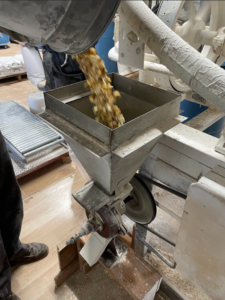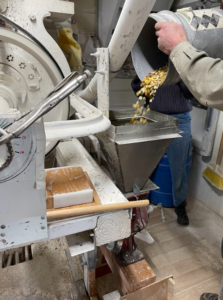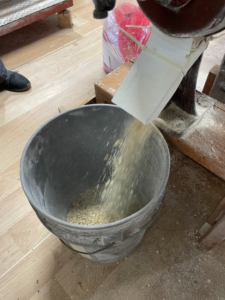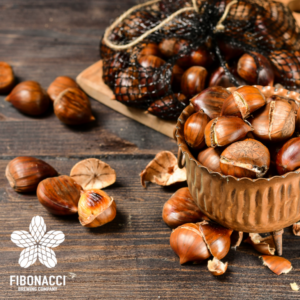Final report for ONC22-111
Project Information
Rural Action will partner with three farmers from the Route 9 Chestnut Cooperative and the Shagbark Seed & Mill to develop value-added fine chestnut flour that can be marketed to our region’s bakeries, restaurants and retail markets.
The demand for culinary chestnuts far exceeds the supply from our region. However, chestnut farmers from the Route 9 Chestnut Cooperative report that up to 20% of their harvest is Grade B (up to 20,000 lbs) and therefore unsellable as fresh chestnuts. These Grade B chestnuts promise a good return if they could be processed into a fine culinary flour, but the system for drying and milling is not yet developed in our region. Currently, the Cooperative uses low-tech equipment to create a coarse flour and does not have the capital to scale up and optimize the process to produce a fine chestnut flour. This project will research and document best milling practices, convene producers at two field days for peer learning, and gather qualitative data from buyers who are provided chestnut flour samples to evaluate. We seek to meet the need of diversifying producers’ chestnut portfolios in order to increase the production of this sustainable, climate-resilient crop.
- Research and develop the processing requirements to make fine chestnut flour out of grade B chestnuts
- Identify the optimal milling equipment needed
- Record best practices for processing at a margin that’s economically viable for the farmer and miller
- Improve chestnut flour product through gathering qualitative data from a select customer base that is given samples to evaluate
- Write elements of a business plan for processing grade B chestnuts that could be incorporated into any chestnut grower business plans
- Host two field days at Route 9 to gather producers and customers to learn about value-added products and chestnut potential
Cooperators
- (Researcher)
- (Researcher)
- (Researcher)
- (Researcher)
- (Researcher)
- (Researcher)
- (Researcher)
- (Researcher)
- (Researcher)
- (Researcher)
Research
Equipment: We purchased a B&W Manufacturing grain aeration pencil dryer from QC Supply to reduce moisture in the nuts prior to milling. The tool consists of a fan head and a 6’ tube that pulls large volumes of hot, damp air out of the chestnuts. This is especially important for milling during the summer months since humidity remains an issue.
Route 9 Cooperative's current process of milling chestnut flour consists of the following steps:
- Air dry chestnuts down to 10-12% moisture using drying boxes. Each box holds about four boxes each of which holds 800-1000 fresh weight (close to 8K lb).
- Peel using an impact peeler.
- Roast in convection ovens (2) at 75C to improve flavor and bring moisture down to 10% based on scent and texture. Typically it takes 2-4 hours to roast 50 lbs.
- Mill into quarter size particles. Milling capacity: feed 25 lbs at a time, takes 10 minutes.
Moisture Levels
Moisture is an ongoing concern during the milling process since chestnuts have a 40-50% water content by mass. The moisture content of the chestnuts was just a bit high during our milling day at Shagbark Seed & Mill in May, as indicated by the tendency of the flour to bridge in the mill and the eventual growth of mold inside the refrigerated flour bags.
Greg Miller of Route 9 Cooperative, previously found that 18% moisture is the threshold for mold in chestnut products. While the batch of chestnuts in May 2022 at Shagbark was below 18% moisture, when the flour was quickly refrigerated after milling, moisture picked up from the high humidity the day of milling concentrated moisture in a small portion of the bag, raising the moisture levels in above the 18% threshold.
In contrast, when Amy Miller took samples back to Route 9 Cooperative from the same milling run, they sat out for a few days before storing them in the fridge which allowed the bags to fully cool and dry before refrigerating.
Regarding mycotoxins in mold, Greg Miller did extensive mycotoxin sampling during his original milling work in the early 90s and at an Iowa State University lab and found no mycotoxins in his samples considered consumable.
Brian Jacobson, Associate Director of Strategic Operations at University of Illinois at Urbana-Champaign is partnering with a PhD candidate Vince Yang to analyze the properties of a mix of chestnut cultivars and offered some advice about dehydration techniques. Using an airflow dryer, they aim to reduce water activity below 0.6 at least, or similar to the wheat flour. However, Amy Miller points out that individual chestnut kernels have very non-uniform drying patterns compared to other grains so the average moisture level of the "batch" doesn't necessarily match the moisture level of any individual kernel. Therefore, she says, “even if nuts are all dried in the same conditions, after four weeks we'll find some kernels so dry that they shatter and others that are still spongy and chewable.” This inconsistency makes it difficult to develop and scale up drying equipment.
Milling
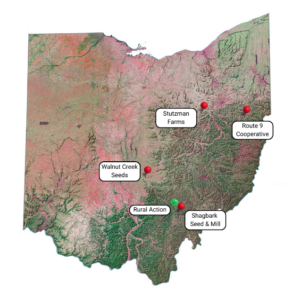
5/13/22 Shagbark Seed & Mill Chestnut Milling
Our first milling day took place at Shagbark Seed & Mill in Athens County on May 13, 2022. We split 140 lbs of chestnut chunks into two milling groups: 800 micron screen and 450 micron screen. A micron, also called a micrometer, is the metric unit of measurement for 0.001 millimeters. It is used here to refer to the diameter of the milled material, so the greater the amount of microns, the larger the particle size.
| Trial | Micron size | Start weight | Total yield | Flour yield | % flour yield |
| 1 | 800 micron | 70 lbs | 63.4 lbs | 52 lbs | 74% |
| 2 | 450 micron | 70 lbs | 68.82 lbs | 25 lbs | 36% |
We then bagged the milled flour (77 lbs) and distributed it to eight local bakers and chefs who produced a range of products including sourdough bread, baguettes, and cake.
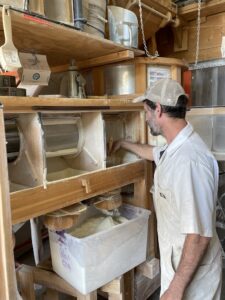
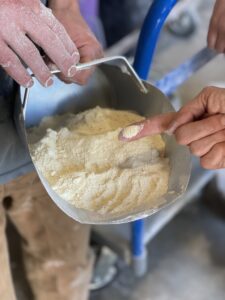
8/23/22 Walnut Creek Seeds Chestnut Sifting
Amy Miller brought sifted combination chestnut flour and a 1cm screened polenta grade chestnut flour to sift at Walnut Creek Seed in Fairfield County. 25.8 lbs of the sifted flour was sifted through a 100 mesh screen to produce 6.85 lbs of ultra-fine flour. The remaining 31.9 lbs of sifted flour was sifted through a 40 mesh screen to produce 20.15 lbs of fine flour. The polenta grade chestnuts were also sifted through the 40 screen to produce 3.8 lbs of fine flour. Total yield was nearly 100% for all the trials on account of the large amounts of ‘leavings’ that remained leftover from the screened flour. These leavings are a coarser grade similar to grits.
Mesh size refers to the number of openings in one inch of screen. For example, an 800-mesh screen means that there are 800 squares within one inch of the screen. As the mesh size increases, the particle size decreases to create a finer milled product (opposite of micron size).
| Trial | Mesh size | Start weight | Total yield | Flour yield | Leavings yield | % flour yield |
| 1 | 100 mesh | 25.80 lbs (sifted combination flour) | 25.80 lbs | 6.85 lbs | 18.95 lbs (fine leavings) | 27% |
| 2 | 40 mesh | 31.90 lbs (sifted combination flour) | 31.85 lbs | 20.15 lbs | 11.70 lbs (coarse leavings) | 63% |
| 3 | 40 mesh | 27.50 lbs (1cm screened polenta) | 27.45 lbs | 3.80 lbs | 23.65 lbs (ultra-coarse leavings) | 14% |
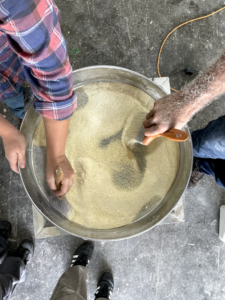
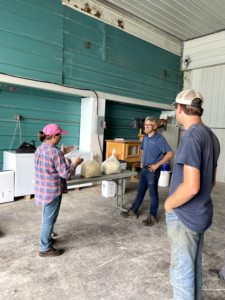
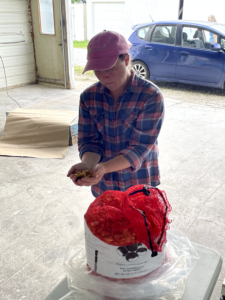
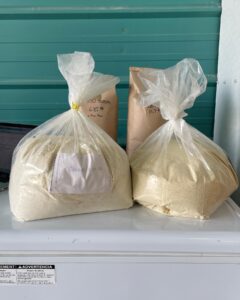
12/2/22: Stutzman Farms Milling and Sifting
Amy Miller of Route 9 Cooperative met us at Stutzman Farms in Holmes County, Ohio to mill 60 lbs of whole chestnut into culinary flour. The whole chestnuts were first run through a burr mill to break into large chunks then milled to make smaller chunks some of which were subsequently put through the third mill to produce a fine flour.
Stutzman milled the fine flour for a cost of $0.75/lb. The other 20 lbs he milled into coarse pieces with the steel burr mill (either 1x or 2x through the mill) at a cost of $0.25/lb. Those 20 lbs were divided into samples of different sizes: Steel burr mill 1X, Steel burr mill 2X, Steel burr mill and Roller mill (settings 1 & 2 on the roller mill). He reported that the moisture in the chestnuts caused the chunks to get lodged in his mill. Stutzman explained that to achieve the fine flour, the chestnuts had to be run three times. Per advice from Amy Miller, he used a pencil dryer to reduce the amount of moisture prior to milling.
Medium and fine chestnut flour was sent to Michell’s Ice Cream (Cleveland) and Jeni’s Splendid Ice Cream (Columbus) for sampling. Remaining samples were distributed to local bakers and chefs to produce products for our OEFFA presentation.
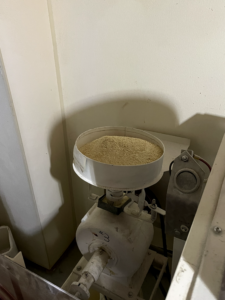
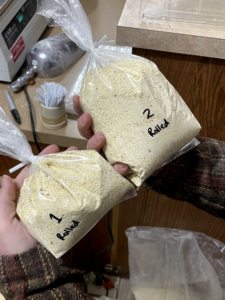
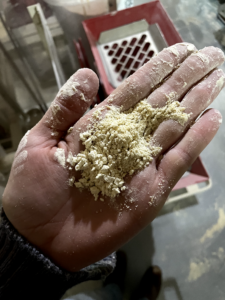
3/21/23: Stutzman Farms Milling and Sifting
Miller Monroe Stuzman suggests that incorporating a hammermill into the small mill operation could significantly expedite the milling process for chestnuts. The advantage of the smaller mill lies in its gluten-free output, a valuable feature if Amy intends to make such a claim. Opting for the larger mill, however, would necessitate a minimum quantity of 300 pounds. Despite this, Miller believes there is sufficient space available for refrigeration of larger quantities. Additionally, he envisions the potential for processing and packaging finished flour and pancake mix, which could undergo initial breakdown in the larger mill before being further refined using a stone mill for a finer flour texture.
Monroe Stutzman mills 97lbs. of chestnuts into smaller chunks.
Brewing
Fibonacci Brewing Company Collaboration
After attending our OEFFA presentation in February of 2023, Alex Rhinehart of Fibonacci Brewing Company purchased 22 lbs of coarse chestnut flour to experiment with chestnut beer at their Cincinnati brewery. The first test beer was produced with dried chestnuts that had been milled to fine flour. The second beer, released in August of 2023, used coarser ground chestnuts that were slightly roasted and brought out a salted caramel flavor. Alex Rhinehart plans to continue to work with Amy to develop a profile of roasted products to use in chestnut beers. Fibonacci Brewing Company is a unique woman-owned nanobrewery and urban farm.
Jackie O's Brewery
Athens brewer Jackie O's experimented with roasted chestnut to produce a 17th Anniversary Chestnut beer. They added dried chestnut chunks from Route 9 to a bourbon barrel aged Barleywine blend along with a touch of toasted cacao nibs to produce a Chestnut and Chocolate Barley Barge.
Recipes
To better aid our research, we distributed a variety of flour types to bakers, chefs, and brewers from our region and beyond to experiment and provide feedback.
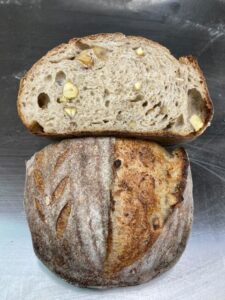

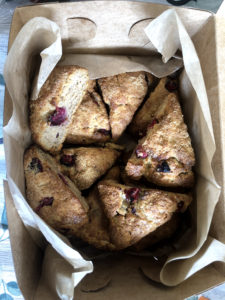
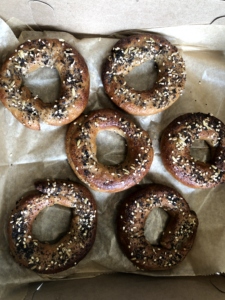

Educational & Outreach Activities
Participation Summary:
2022 Field day: Our Chestnut Field Day held at Route 9 Cooperative on September 30, 2022, garnered more than 20 attendees from across the state to learn about the grant research, tour the processing facility, and test the value-added chestnut flour products made by local chefs and bakers.
Event agenda:
-
- 2-2:15pm: welcome and food introduction
- 2:15-3pm: slide presentation and questions
- 3-3:45pm: facility tour
- 3:45-4pm: questions and close
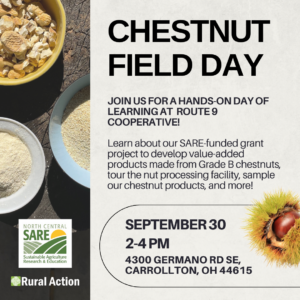
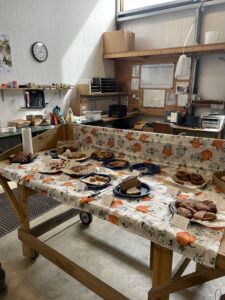
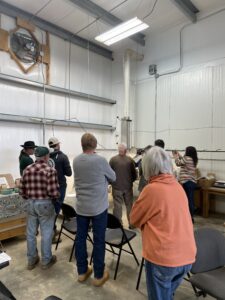
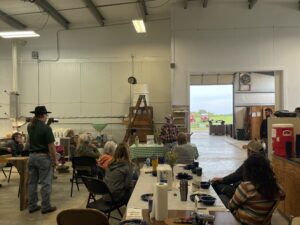
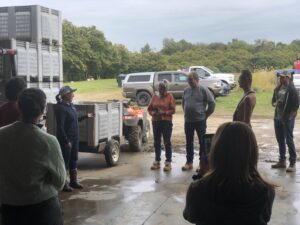
2023 Field Day: Over 25 farmers, researchers, food industry professional, and members of the general public attended our second field day on August 12, 2023. Similar to the previous year's event, guests toured the facility and orchard, learned about our research findings, witnessed the processing chain, and sampled chestnut products.
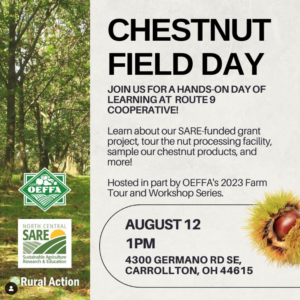
Promotion: Our grant research and field day events were promoted through ATTRA, Morning Ag Clips, OEFFA, and featured in Cleveland’s WKYC news. Our grant work was also featured in several articles and even a Belgian documentary.
Within Rural Action’s network, our research was also highlighted in three newsletters including the Staple Pulse, Rural Action's Sustainable Agriculture and Forestry Newsletter, and Rural Action's Rural Rambler Newsletter, cumulatively reaching 8.4k readers.
Published articles:
- 4/21/23: Farm and Dairy interviewed Amy Miller and Michelle Ajamian about our work for an article titled "Growing demand in Ohio for culinary chestnuts fuels renewed interest in North American tree".
- 4/26/23: Brew Bound published an article about the Fibonacci Brewing Company collaboration with Route 9 and Rural Action titled "Fibonacci Brewing Company Unveils Castanea No.9, The First of Its Kind Chestnut Beer". This partnership was also featured in several other craft brewing publications including Craft Brewing Business, The Gnarly Knome, and American Craft Beer.
- 8/6/23: Videographers from Belgium visited Route 9 Cooperative to interview Amy and sample chestnut products for a film about perennial agriculture. Local bakeries provided chestnut scones, pizza, taralli, clafouti, pound cake, and more to be featured in the video and Fibonacci Brewing of Cincinnati brought their craft chestnut beer for sampling.
- 8/15/23: Amy, Michelle, and a participating Athens baker were interviewed by the Ohio Statehouse Newsroom about our grant work for the article "Corn, soybeans and ...chestnuts? Ohio farmers find new uses for the uncommon crop". The story was also featured on local NPR stations.
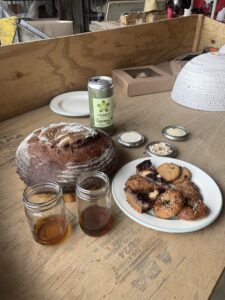
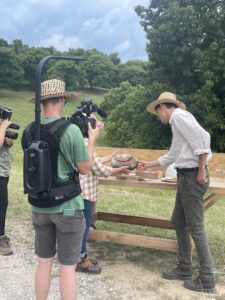
Presentations: Amy Miller (Route 9 Cooperative), Michelle Ajamian (Rural Action), and Eleanor Reagan (Rural Action) presented our SARE research project at the OEFFA (Ohio Ecological Food & Farm Association) Conference on February 17, 2023. We shared educational materials, prepared presentation slides, and collaborated with local bakers to provide samples of our chestnut flour products.
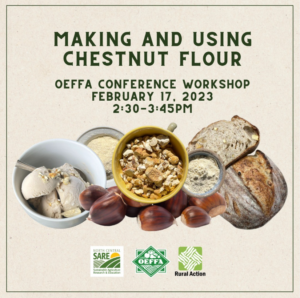
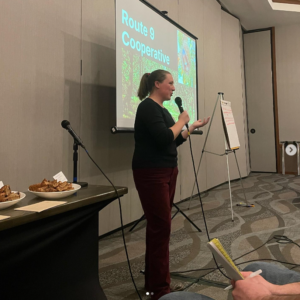
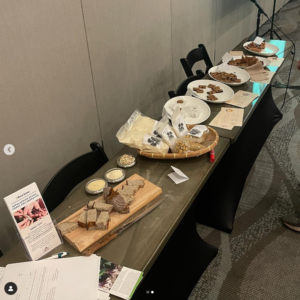
Future Outreach: We recognize the importance of promoting our work beyond Rural Action’s social media accounts to ensure outreach continues beyond the grant timeline. To that end, we will be assisting Route 9 Cooperative with creating and maintaining an active social media presence in the second year of the grant.
We also connect with food manufacturers and distributors to promote sales to food service customers. Finally, we plan to seek out venues and events that will feature chestnut flour and pancake mix to the general public.
Learning Outcomes
Project Outcomes
Project Outcomes
We’ve connected with a number of chefs, bakers, brewers, and retailers to increase the economic opportunities of value-added chestnut products. Our goal is to create interest in the prospect of purchasing course and fine flour, as well as chunks that can be used as ingredients in new menu items. Route 9 saw an increase in sales after we distributed chestnut flour samples to chefs.
- Monroe Stutzman of Stutzman Farms purchased chestnut chunks from Route 9 Cooperative after collaborating on the grant. He plans to mill the chestnuts into flour to sell at his facility in Millersburg, OH.
- Monroe Stutzman developed a pancake mix of the chestnut flour and his spelt flour that Route 9 started selling at the OEFFA conference, where it sold out on the first day.
- Andrew Luxmore of Blue Hill at Stone Barn purchased just over 100 lbs to use in research and development for Blue Hill restaurants in NYC and at Stone Barns Tarrytown, NY in December 2022. Specifically, they ordered 20 lbs fresh chestnuts in shell, 10 lbs fresh peeled kernels, 5 lbs dried kernels, 60 lbs fine flour; and received a sample of 10 lbs coarse flour Route 9 Cooperative. They produced a chestnut butter and tart shell for the restaurant. He contacted Route 9 to get on the list to ensure they would be able to purchase flour after the 2023 harvest to use in their annual fall menu.
- Fibonacci Brewery is committed to making a chestnut beer at their Cincinatti brewery.
- Our August 2023 field day included nearly 25 producers who learned about the potential of growing chestnuts on their farms. The field day included a tour of the orchards, tasting products made with the flour, and a presentation by Route 9 Coop members.
- Participating bakeries let us know that many of their customers were eager to purchase more bread made with chestnut flour when the flour became available after the 2023 harvest.
- After sharing our work with the Craft Millers Guild list, we learned that two mills, Capay Mills in California and Naga Bakehouse in Vermont purchased chestnut flour from Route 9.
- Baker Grace Jones created several recipes she posted on Instagram (@thegoodoneshomestead) and told us in our survey that she would purchase up to 50# of flour a year from Route 9.
- Athens brewer Jackie O's sampled Route 9 Cooperative chestnuts in a limited edition beer for their 17th anniversary celebration. The Chestnut & Chocolate Barley Barge was a blend of bourbon barrel aged barleywines conditioned on Ohio Chestnuts and Ecuadorian cacao nibs. The brewers found that chestnut chunks lent themselves best to stout beers given the low carbonation.

Jackie O's Anniversary chestnut beer.
Tree crops, specifically chestnut trees, offer a range of ecological benefits including carbon sequestration, soil stabilization, and opportunities for alley cropping. In Appalachia, small, irregular plots with acid soil types are well suited to chestnut trees. By increasing market interest in culinary chestnuts and standardizing milling methods, our work incentivizes farmers to incorporate chestnut trees amongst existing crops and even creates viable alternatives to traditional row crops.
The NCR-SARE grant, Value Adding Culinary Chestnut Seconds Through the Development of a Marketable Fine Flour, was met with enthusiasm from the businesses that received samples of the flour produced at the mill at Stutzman Farm in Holmes County.
In an interview with Brew Bound, the owner/brewer at Fibonacci Brewing Company said, “Bringing Castanea No. 9 to life with Route 9 Chestnut Coop and their (Rural Action) partners has been a wonderful project. (We) first discussed brewing with chestnuts several years ago...
In emails and survey responses, they went on to explain that Route 9 did all the roasting, and that they had worked together to create an ingredient that brewers would appreciate. Starting with a fine flour and then moving on to a course flour of chestnuts that were slightly roasted, the final roast brought out a salted caramel type flavor. They expect to purchase 200 lb of flour annually for this unique brew.
They told us that they have a planned a pilot series to feature chestnuts, including creating a brew that will use chestnuts can to make small batch gluten free beers.
"This unique chestnut beer is a tribute to the rich culinary and brewing history of the chestnut and a testament to the power of community...Our plan is to continue to work with (Route 9) to develop a profile of roasted products to use in chestnut beers."
The market forager at the Blue Hill restaurant at Stone Barns in New York State, purchased flour last year for their gourmet pie crusts and chestnut butter, and reached out this fall asking if they could purchase "25# or your excellent, fine chestnut flour." Blue Hill at Stone Barns started in 2004 by Dan Barber, Michelin Chef and best selling author who is focused on sustainable agriculture.
The woman behind The Good Ones Homestead made a traditional Tuscan cake/crepe - chestnut flour, water, olive oil, honey, pine nuts, walnuts, dried service berries and rosemary and other cakes she posted on her Instagram account. She told us that she expects to purchase up to 50 lb. a year.
Finally, the miller at Stutzman Farm expressed their excitement about developing a chestnut/spelt pancake mix, which is sold through their farm store and Route 9's online shop page.
Recommendations for future research:
- Explore the development of an appropriately-sized drying equipment. This is due to our challenges with the pencil dryer being too large for the batch sizes that Route 9 prepared for milling .
- Explore the efficiency of using a hammermill before running the chestnuts through a stone mill, per Monroe Stutzman's suggestion.
- Explore the possibility of using one of the local coffee company’s coffee roaster for smaller batches.
- Develop a social media platform and website shop page that better performs and encourages more followers and sales.
